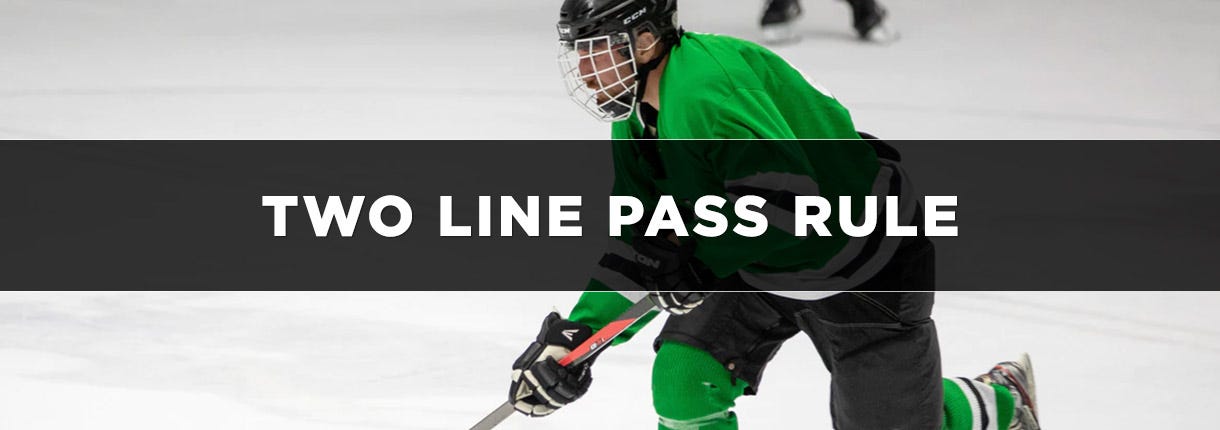Two Line Pass Rule: How the NHL Removing it Changed Hockey

The two-line pass rule in ice hockey is when a stoppage of play is called because a pass was made from inside of a team’s defending zone to a player that is on the offensive side of the blue line, meaning the puck has crossed both the defending team’s blue line and the red line during the pass. The only time this is not called is if the puck crosses the red line before the receiving player. As most know, this rule has been eliminated from the current NHL rules, so within this article, we will explain why it was removed, as well as the impact of removing the rule had on the league, along with a brief history of the rule.
The History of the 2 Line Pass Rule
In 1943 through 2005, a rule known as the 2-line pass rule was used league wide. This rule prevented teams from passing the puck from their defensive zone to a player that was already on the opposing team’s side of the red line. This rule was implemented with the hopes of essentially eliminating the amount of cherry-picking teams did. Cherry picking is when a team would send one player out and have them roam around on the opposing team’s side of the red line with the hopes of receiving a pass and skating in for an uncontested shot on net.
As a downside, defenses quickly learned to use this rule to their advantage by sending all five of their players into the offenses neutral zone (known as the neutral zone trap), making it very hard for teams to advance the puck up the ice, whether it be by passing or by skating it up the ice. And defending teams could afford to do this, knowing that if a player received a pass behind them (in their defending neutral zone) that the play would be stopped due to the 2-line pass rule. As a result of this rule, games were very defense-heavy and were often times very low scoring, with an average of just three total goals scored per game.
Another potential reason as to why the 2-Line Pass Rule was implemented into the game was because of the size of goalie pads. Compared to modern NHL goalies, goalie pads from decades back were significantly smaller in size. Everything from leg pads, all the way up to the helmets. Therefore, in theory, smaller pads equals more goals let in. So, to offset this, the NHL introduced this rule. In the modern game of ice hockey, goalie pads are much more advanced and bigger in size, to keep up with the ever-advancing technology found within hockey sticks and blades.
Why the NHL Removed the Two-Line Pass Rule
From the mid 1990’s until the 2004 season, goals per game averages were some of the lowest the league had ever seen, averaging around just 2.5 per game. Games were drawing less and less fans, less games were being televised, meaning less money being generated overall, which lead to unhappy fans, staff, and players. Due to this, no hockey games were played during the entire 2004-2005 season, which is known as an NHL lockout. Looking to resolve these issues, the league board implemented a few changes to the rules, envisioning an overall increase of excitement in ice hockey games. The main change being the removal of the two-line pass rule, which was made with the hopes of increasing the amount of goals scored per game. This meant longer, “stretch passes”, set plays in the offensive zones, allowed for teams to utilize more of the open ice when they have the puck, and a faster-paced game overall. Since the 2005 season, this rule has not been used in the NHL, and the game of ice hockey has changed immensely because of it.
The elimination of the 2-Line Pass Rule has changed the game of Ice Hockey in a multitude of different ways. However, whether or not the initial objective of it’s removal was met is a different story. Looking at goal scoring averages per from the late 80’s to the early 90’s, goal scoring has actually gone down slightly since the removal of the rule for the 2005 season. Of course, there are a few factors to this, namely the aforementioned goalie pad sizes as well as teams greatly improving their defensive strategies. This past season, an average of 3.01 goals were scored per game, compared to the 80’s and 90’s were games were averaging close to 4.00 goals a game.
Perhaps the most noticeable change since the removal of the 2-Line Pass Rule is how much it has “opened up” the game. “Opened up” means that the game now is much more free-flowing, faster, and allows for players to better utilize their speed due to more open ice. If available, players can now stand behind their goal, fire a pass to an open teammate standing in front of the opposing team’s blue line, and go in for a breakaway and that would be perfectly legal. As of late, we have seen defensemen in their zone that fire passes up the ice to a winger coming on to the ice from a line change, already in full stride. They receive the puck on their stick right as they are about to cross the blue line, and already at full speed, are able to easily get past the opposing defensemen for a shot on net.
Another interesting play that we see more so now than ever is the use of goalies, specifically coming out of their crease and making passes. Recently, we have seen number of goalies who had the puck on their stick, were able to locate an open winger down the ice, past the red line. The goalies would launch the puck up the ice to their open winger with him often times receiving it in full stride, and within the opposing team’s neutral zone, for an uncontested shot on the opposing goalie.
With these changes to the game, because of the removal of the 2-Line Pass Rule, Ice Hockey is faster than it has ever been. This style of gameplay has led to the emergence of quick, fast skaters like Connor McDavid, who utilize their speed, stickhandling abilities, and hockey IQ to find open space on the ice and make plays for their teammates by controlling the offensive zone.
On the contrary, as the game has opened up since the removal of the 2-Line Pass Rule, this has made the game a little bit more dangerous. Since the game is faster than it has ever been before, with more open ice for players to skate, we are seeing more big, open-ice hits. With team’s often times looking to make a long, stretch pass to an open winger, sometimes those wingers are not aware of a defenseman that is lurking in that same vicinity, resulting in a potentially dangerous hit. Due to this, hockey companies like CCM, Warrior, and Bauer are constantly looking for ways to improve hockey helmets to further reduce the number of head injuries.
The Two Line Pass Rule in Other Leagues
Following the NHL’s removal of the Two-Line Pass Rule in 2004-2005, other leagues around the world began to follow suit. Professional leagues like the American Hockey League (AHL) and the Kontinental Hockey League (KHL) saw to it’s removal for their 2005-2006 season. Additionally, junior hockey leagues around the world like the Ontario Hockey League (OHL) and the United States Hockey League (USHL) removed the rule around this same time as well.
AHL
The Two-Line Pass Rule was eliminated from the AHL at the beginning of the 2005 season. Since the AHL serves as the primary developmental league for the NHL, the league board wanted to remain as close as possible to the NHL rules. This decision helps develop players under the same framework of playing standards set in stone by the NHL.
KHL
Founded in 2008, the KHL is widely regarded as the top professional hockey league in Europe, and second to the NHL. Made up from ex-NHL players, the KHL adopted almost all of the rules from the NHL, including the non-use of the Two-Line Pass Rule.
International Play (IIHF World Junior Championship, World Championships)
The International Ice Hockey Federation is the governing body for ice hockey and hosts multiple worldwide tournaments a year, the biggest being the World Junior Championships and the World Championships. A majority of the players playing in these two tournaments already have roles within NHL organizations, so the IIHF board tries to keep the rules on-par with the NHL rules, although there are a few differences. One that both have in common is the non-usage of the Two-Line Pass Rule. However, in 2014, a proposal was made to reinstate this rule moving forward, but was ultimately rejected. There are a number of factors as to why the league board was calling for this rule to be brought back, especially for international play.
Reason for Reinstatement
Years following the removal of the Two-Line Pass Rule, people within the hockey world have made arguments of why they believe the rule should be brought back. The primary objective of getting rid of the rule in the first place was to ultimately make the game more exciting by scoring goals. The argument to this from some is that while the game has gotten faster, removing the rule has had little to no effect in terms of upping the goals per game average. Furthermore, as removing the rule has made the game inarguably faster due to more open ice, some believe this has led to more injuries. With players now having the ability to fire the puck up the ice, it could potentially leave them susceptible to a huge open ice hit because they were preoccupied with looking for that long stretch pass. Lastly, some argue that it has lead to a decrease in skill over within the league. This is because often times teams will simply dump the puck into the zone and let one of their speedy skaters outrace the defensemen, as opposed to strategically skate and/or pass the puck out of the zone.
Summary
Despite the removal of the Two-Line Pass Rule, it is unlikely that we will return to the goal scoring averages of 4.0, as seen in the 80’s. However, although it has been removed, the game of Ice Hockey can now be entertaining for all types of fans. Whether you are a fan of low-scoring and strategic defensive games with big saves from goalies, or prefer to watch high-scoring games, with flashy goals, the game of Ice Hockey is sure to keep you on the edge of your seat!









Login and Registration Form
or
Create an account